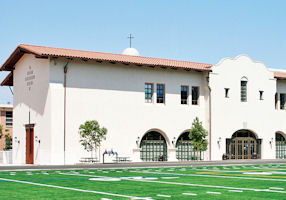Competition for students is fierce among the Valley area’s largest private schools. But with tuition approaching Ivy League university costs at many campuses – in excess of $30,000 a year at the most expensive schools – parents want more than just the requisite top academic scores and athletic records. Schools need to stay ahead of the game by offering an increasing number of specialized programs, state-of-the-art classrooms and even flexible learning schedules. Consider Chaminade College Preparatory in West Hills, which is No. 2 on this year’s list of private high schools ranked by enrollment. Each student is issued a tablet PC that is connected to the school’s “smart” classroom displays, which allow students and teachers to interact during lectures – and in many ways replace old-school pen and paper notes. “It catalogues all their work, so they can go back and access old notes and research previous work,” said Chaminade spokeswoman Patricia Fernandez. “And it allows the kids to collaborate, talk to the teachers and ask a question if they need to during class. The kids really love it.” The cost of the tablets is part of the school’s annual tuition, which comes in at $12,925. The school launched the program in early 2012, and plans on continuing to further integrate the technology into learning objectives. It’s these kinds of advantages that have helped private schools largely rebound from a dip in enrollment at the height of the recession. The latest list of schools have total high school enrollment ranging from just 135 students at Concordia Junior/Senior High School in Sylmar to 1,643 at the Catholic Bishop Alemany High School in Mission Hills. Chaminade may be leading the charge toward an integrated digital learning experience, but digital education is now expected at most private schools. North Hollywood’s Campbell Hall has also integrated its classrooms with so-called SmartBoards, interactive white boards that allow teachers to save handwritten notes and lectures and later share those notes with students electronically. And even lower grades use iPads. “Kindergarten through sixth grade students have regular access to iPads. We have a one-to-one program in the seventh and eighth grades,” said Annie Block, the school’s director of advancement. But not all schools are sold on shelling out thousands of dollars for tablet devices for each student. At Crespi Carmelite High School in Encino, the all-male parochial school has encouraged technology integration. But students use their own devices, and frequently for homework rather than in-class. “We’ve adopted a ‘bring-your-own-device’ platform,” said Jonathan Schild, vice president of academics for the school. “We have students coming out of a wide variety of different feeder schools with different experiences and we didn’t want to retrain them. So they can use whatever they have.” However, the school has embraced the so-called “flip teaching” method. Videos and online lectures are frequently assigned as homework so that class time is dedicated to hands-on activities and seminar-style learning. In your seat Class times have also become a somewhat fluid idea at several local schools. Campbell Hall has adopted later start times to reflect internal studies showing adolescents learn better later in the day. One new school, Woodland Hills’ Halstrom Academy, has done away with the start time all together. The school, which opened its Valley location in Woodland Hills in January, has several other campuses in Southern California. It is built on a project- and hour-based system that lets students take classes online or come to school for one-on-one learning. “We make the learning very flexible, so that it works for kids whose parents have a non-traditional schedule or for students who are pursuing other outside pursuits,” said Ramon Dourado, chief executive at Halstrom. What happens during class is also changing. Area schools are increasingly focusing on specialized programs, both in the classroom and after school. Crespi has an environmental leadership program offered to all grade levels. Students learn about environmental principles in seminars throughout the year and participate in overnight backpacking trips and environmental service projects. “Needless to say, it’s one of our most popular extracurricular activities,” said Schild. “But it’s these sorts of programs that set you apart as a school.” Download the 2013 VALLEY’S LARGEST PRIVATE HIGH SCHOOLS list (pdf) Download the 2013 VALLEY’S LARGEST PUBLIC HIGH SCHOOLS list (pdf)
